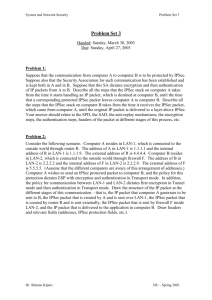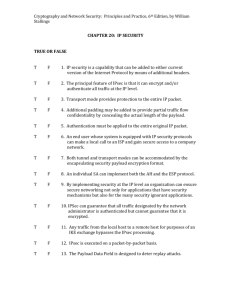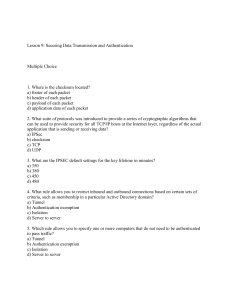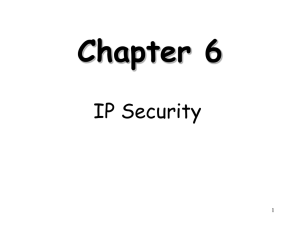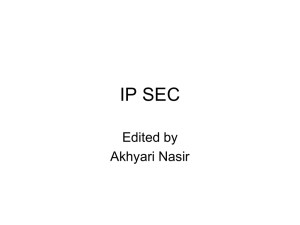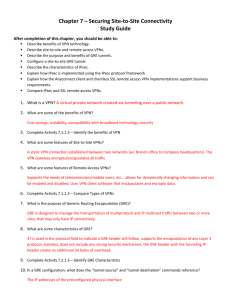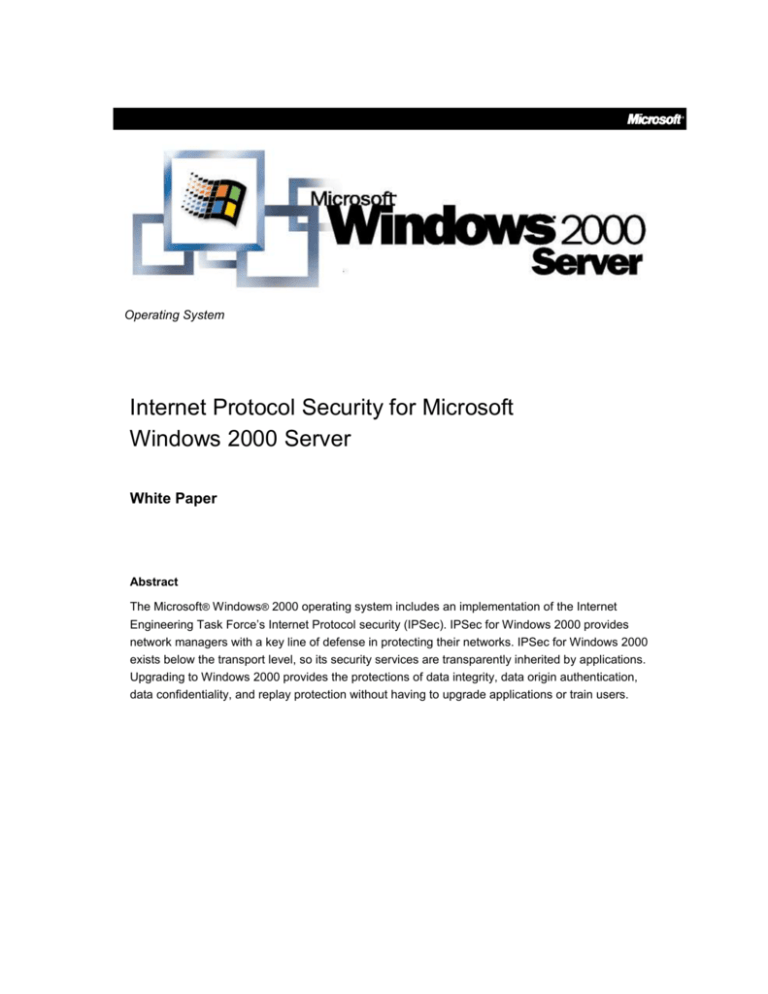
Operating System
Internet Protocol Security for Microsoft
Windows 2000 Server
White Paper
Abstract
The Microsoft® Windows® 2000 operating system includes an implementation of the Internet
Engineering Task Force’s Internet Protocol security (IPSec). IPSec for Windows 2000 provides
network managers with a key line of defense in protecting their networks. IPSec for Windows 2000
exists below the transport level, so its security services are transparently inherited by applications.
Upgrading to Windows 2000 provides the protections of data integrity, data origin authentication,
data confidentiality, and replay protection without having to upgrade applications or train users.
© 1999 Microsoft Corporation. All rights reserved.
The information contained in this document represents the current view of Microsoft
Corporation on the issues discussed as of the date of publication. Because Microsoft
must respond to changing market conditions, it should not be interpreted to be a
commitment on the part of Microsoft, and Microsoft cannot guarantee the accuracy
of any information presented after the date of publication.
This White Paper is for informational purposes only. MICROSOFT MAKES NO
WARRANTIES, EXPRESS OR IMPLIED, IN THIS DOCUMENT.
Microsoft, the BackOffice logo, Windows, and Windows NT are either registered
trademarks or trademarks of Microsoft Corporation in the United States and/or other
countries.
Other product or company names mentioned herein may be the trademarks of their
respective owners.
Microsoft Corporation • One Microsoft Way • Redmond, WA 98052-6399 • USA
0399
CONTENTS
INTRODUCTION .......................................................................... 1
BENEFITS OF IP SECURITY ........................................................ 3
Building upon IPSec
3
Full Support of Industry Standards
3
Diffie-Hellman (DH) Key Exchange
3
Hashed Message Authentication Code (HMAC)
4
HMAC-MD5
4
HMAC-SHA1
4
DES-CBC
4
3DES
4
Supported Standards and References
4
Flexible Security Protocols
5
Internet Key Exchange
5
Authentication Header
5
Encapsulating Security Payload
5
Cost Savings
5
Software Upgrades
6
Training
6
Cryptographic Key Management
6
DEPLOYING IPSEC FOR WINDOWS 2000 ................................... 7
IPSec Deployment Process
7
Evaluating Information Sent Over the Network and the Internet
7
Creating Scenarios
7
Determining Required Security Levels
7
Building Security Policies with the IP Security Policies Snap-in
7
IPSec Policies
7
IPSec Policy Rules
8
Example of Configuring an IPSec Policy
8
How IPSec Works
10
Compatibility With Older Versions of Windows
11
Compatibility With Routers and Firewalls
11
SUMMARY ................................................................................. 12
FOR MORE INFORMATION ........................................................ 13
INTRODUCTION
The Microsoft® Windows® 2000 Server operating system simplifies deployment and
management of network security with Internet Protocol security (IPSec) for
Windows 2000, a robust implementation of the IPSec Internet standards. Windows
XP also supports IPSec.
The need for Internet Protocol (IP)–based network security is already great and is
growing. In today’s massively interconnected business world of the Internet,
intranets, branch offices, and remote access, sensitive information constantly
crosses the networks. The challenge for network administrators and other
information technology (IT) professionals is to ensure that this traffic is:
Safe from data modification while in transit.
Safe from viewing.
Safe from being accessed by unauthenticated parties.
These issues are known as data integrity, data confidentiality, and data origin
authentication. In addition, replay protection prevents an attacker from submitting a
previously captured packet to gain access to protected resources.
Designed by the Internet Engineering Task Force (IETF) for IP, IPSec supports
network-level data origin authentication, data integrity, data confidentiality, and
replay protection. IPSec integrates with the inherent security of the Windows 2000
Server operating system to provide the ideal platform for safeguarding intranet and
Internet communications.
IPSec for Windows 2000 uses industry-standard encryption algorithms and a
comprehensive security management approach to provide security for all TCP/IP
communications on both sides of an organization’s firewall. The result is a
Windows 2000 Server end-to-end security strategy that defends against both
external and internal attacks.
Because IPSec for Windows 2000 is deployed below the transport level, network
managers (and software vendors) are spared the trouble and expense of trying to
deploy and coordinate security one application at a time. By deploying
Windows 2000 Server, network managers provide a strong layer of protection for
the entire network, with applications automatically inheriting the safeguards of
Windows 2000 Server security. The encryption support of IPSec for Windows 2000
also extends to virtual private networks (VPNs).
Network administrators and managers benefit from integration of IPSec with
Windows 2000 Server for a number of reasons, including:
Open industry standard—IPSec provides an open industry-standard
alternative to proprietary IP-based security technologies. Network managers
benefit from the resulting interoperability.
Transparency—IPSec exists below the transport layer, making it transparent
to applications and users, meaning there is no need to change network
applications on a user's desktop when IPSec is implemented in the firewall or
router.
Internet Protocol Security for Microsoft Windows 2000 Server
1
Authentication—Strong authentication services prevent the acceptance of
data through the use of falsely claimed identities.
Confidentiality—Confidentiality services prevent unauthorized access to
sensitive data as it passes between communicating parties.
Data origin authentication and integrity—Data origin authentication and
integrity is provided by a hashed message authentication code (HMAC) value,
which is included in every packet.
Dynamic rekeying—Dynamic rekeying during ongoing communications
eliminates manual reconfiguration of secret keys and helps protect against
secret key determination.
Secure links end to end—IPSec for Windows 2000 provides secure links endto-end for private network users within the same domain or across any trusted
domain in the enterprise.
Centralized management—Network administrators use IPSec policies to
provide appropriate levels of security, based on user, work group, or other
criteria. Centralized management reduces administrative overhead costs.
Flexibility—The flexibility of IPSec for Windows 2000 allows policies to apply
enterprise-wide or to a single workstation.
All of this is good news to network managers and other IT professionals tasked with
protecting the security of information. The explosive growth of intranets and the
increasing integration of corporate networks with the Internet have caused an even
greater need for security. Although the classic security concern is to protect data
from outside attackers, IPSec for Windows 2000 also provides protection against
attacks from what is the more likely source—unauthorized access by insiders.
Whether IPSec policies are in place for key workgroups or the entire network, the
security services of IPSec for Windows 2000 can provide network managers with
the peace of mind that comes from protecting an enterprise’s communications.
Internet Protocol Security for Microsoft Windows 2000 Server
2
BENEFITS OF
IP SECURITY
Most network security strategies have focused on preventing attacks from outside
the organization’s network. Firewalls, secure routers, and token authentication of
dial-up access are examples of attempts to defend against external threats. But
strengthening a network’s perimeter does nothing to protect against attacks
mounted from within. An organization can lose a great deal of sensitive information
from internal attacks mounted by employees, supporting staff members, or
contractors, as firewalls offer no protection against internal threats.
One of the great benefits of IPSec for Windows 2000 is the ability to protect against
both internal and external attacks. This is done transparently, imposing no effort or
additional overhead on individual users.
Building upon IPSec
IPSec, as defined by the IETF, uses an Authentication Header (AH) and an
Encapsulating Security Payload (ESP). AH provides data origin authentication, data
integrity, and replay protection. ESP provides data confidentiality, in addition to data
origin authentication, data integrity, and replay protection.
IPSec for Windows 2000 builds upon the IETF model by mixing public-key and
secret-key cryptography and by providing automatic key management for
maximized security and high-speed throughput. Organizations can automatically
achieve high levels of network security.
IPSec for Windows 2000 features include:
Full support of industry standards
Flexible security protocols
Easy implementation and management
Flexible security policies
Flexible negotiation policies
Cost savings
Full Support of Industry Standards
Windows 2000 makes full use of powerful, industry-standard cryptographic
algorithms and authentication techniques. These include:
Diffie-Hellman key exchange to agree upon a shared, secret key.
Hashed message authentication code (HMAC) algorithms to provide data origin
authentication and data integrity.
Data Encryption Standard with cipher block chaining (DES-CBC) and Triple
DES (3DES) for data confidentiality.
Diffie-Hellman (DH) Key Exchange
The Diffie-Hellman key exchange (named for its inventors Whitfield Diffie and Martin
Hellman) is a public key cryptography algorithm that allows two communicating
entities to agree on a shared key. Diffie-Hellman key exchange starts with the two
entities exchanging public information. Each entity then combines the other's public
Internet Protocol Security for Microsoft Windows 2000 Server
3
information along with its own secret information to generate a common secret
value.
Hashed Message Authentication Code (HMAC)
HMAC is a hash calculation that incorporates a secret key, providing data integrity
and data origin authentication. If the message was not created by a peer that has
knowledge of the secret key or is changed in transit, the verification of the HMAC
value fails and the IP packet is silently discarded.
HMAC-MD5
HMAC-Message Digest function 5 (MD5) is an HMAC algorithm that produces a
128-bit value.
HMAC-SHA1
HMAC-Secure Hash Algorithm 1 (SHA1) is an HMAC algorithm that produces a
160-bit value. While somewhat slower than HMAC-MD5, HMAC-SHA1 is more
secure.
DES-CBC
DES-CBC is a secret key encryption algorithm providing data confidentiality that
uses a 56-bit secret key.
3DES
IPSec for Windows 2000 also supports the use of 3DES, which uses three different
56-bit secret keys.
Supported Standards and References
Windows 2000 fully supports and employs protocols published by the IETF. The
implementation is compliant with the following IETF RFCs and Internet drafts of the
IPSec working group:
Internet Protocol Security for Microsoft Windows 2000 Server
RFC 1828: IP Authentication using Keyed MD5
RFC 1829: The ESP DES-CBC Transform
RFC 2085: HMAC-MD5 IP Authentication with Replay Prevention
RFC 2104: HMAC: Keyed-Hashing for Message Authentication
RFC 2401: Security Architecture for the Internet Protocol
RFC 2402: IP Authentication Header
RFC 2403: The Use of HMAC-MD5-96 within ESP and AH
RFC 2404: The Use of HMAC-SHA-1-96 within ESP and AH
RFC 2406: IP Encapsulating Security Payload (ESP)
RFC 2407: The Internet IP Security Domain of Interpretation for ISAKMP
RFC 2408: Internet Security Association and Key Management Protocol
(ISAKMP)
RFC 2409: The Internet Key Exchange (IKE)
RFC 2410: The NULL Encryption Algorithm and Its Use with IPSec
RFC 2411: IP Security Document Roadmap
4
RFC 2451: The ESP CBC-Mode Cipher Algorithms
A GSS-API Authentication Method for IKE (draft-ietf-ipsec-isakmp-gss-auth0x.txt)
Flexible Security Protocols
Security protocols perform various services for secure network communications.
Windows 2000 uses the following security protocols:
Internet Key Exchange
Authentication Header
Encapsulating Security Protocol
Internet Key Exchange
Before IP packets can be transmitted from one computer to another, a security
association (SA) must be established. An SA is a set of parameters that defines the
services and mechanisms, such as keys, necessary to protect communications for a
security protocol. An SA must exist between the two communicating parties using
IPSec. Internet Key Exchange (IKE) is a combination of the following:
Internet Security Association and Key Management Protocol (ISAKMP), which
defines a common framework to support the establishment of security
associations. ISAKMP is not linked to one specific algorithm, key generation
method, or security protocol.
Oakley, a key determination protocol that uses the Diffie-Hellman key exchange
algorithm. Oakley supports Perfect Forward Secrecy (PFS), which ensures that
if a single key is compromised, it permits access only to data protected by a
single key. It never reuses the key that protects communications to compute
additional keys and never uses the original key-generation material to compute
another key.
Authentication Header
Authentication Header (AH) provides data integrity, data origin authentication, and
anti-replay for the entire IP packet. Data confidentiality is not a property of AH. AH
uses an HMAC algorithm (such as HMAC-MD5 or HMAC-SHA1) to compute a
keyed message hash for each IP packet.
Encapsulating Security Payload
Encapsulating Security Payload (ESP) provides data integrity, data origin
authentication, anti-replay, and data confidentiality for the ESP payload. ESP does
not protect the IP header. ESP uses the DES-CBC or 3DES-CBC algorithms to
provide data confidentiality, in addition to HMAC-MD5 or HMAC-SHA1 for data
integrity and data origin authentication.
Cost Savings
Historically, organizations have had to strike a difficult balance between the desire
Internet Protocol Security for Microsoft Windows 2000 Server
5
to protect their data communications and the high costs of establishing and
maintaining that protection. Security can impose costs that exceed the hardware
cost of the network. These costs have fallen into the following categories:
Software upgrades
Training
Cryptographic key management
Software Upgrades
Because IPSec for Windows 2000 is deployed at the transport level, it is transparent
to existing software applications. With IPSec for Windows 2000 providing security
for the network, applications inherit this security, and no application modifications
are needed. Network-level security provides for immense savings by eliminating the
need to upgrade applications.
Training
Because IPSec for Windows 2000 is transparent to users, no user training is
required, and this expense is eliminated.
Cryptographic Key Management
To provide security, cryptographic keys must be changed regularly. When a network
administrator has to do this manually, key management becomes extremely timeconsuming. Therefore, either the keys are not changed as frequently as the
organization may want, or they are changed on only a few vital computers. IPSec
for Windows 2000 automatically handles key management, which includes the
determination of initial secret keys and the automatic determination of new keys.
The costs of manually changing keys are eliminated, and maximum protection can
be established and maintained across the enterprise.
Internet Protocol Security for Microsoft Windows 2000 Server
6
DEPLOYING IPSEC FOR
WINDOWS 2000
Microsoft Windows 2000 Server has been designed to provide very high levels of
data security coupled with ease of implementation and administration. The result is
enterprise-wide information security at a low total cost of ownership. Windows 2000
Server provides great flexibility with security, user, and domain policies. The
network administrator can apply policies enterprise-wide or down to a single user or
workstation. Security policies can then be implemented transparently, with no
further intervention required from the network administrator and no retraining of
users.
IPSec Deployment Process
To establish security, a network administrator goes through the following process:
Evaluating information sent over the network and the Internet
Creating communication scenarios
Determining security levels required for each scenario
Building security policies using the IP Security Policies snap-in
Evaluating Information Sent Over the Network and the Internet
All information sent over networks or over the Internet is subject to interception,
examination, and modification. A network administrator can determine the types of
information are most valuable and the communication scenarios are most
vulnerable.
Creating Scenarios
Organizations have certain patterns to their information flows. A network
administrator can determine these predictable patterns. For example, remote sales
offices may send projected sales data, purchase orders, and other financial
information to the home office. Each of these communication scenarios can have
different IPSec policies. A network administrator might also decide, for example,
that all communications within the human resources department should be secure.
Determining Required Security Levels
The required security levels change, depending upon the sensitivity of the
information and the relative physical vulnerability of the network infrastructure. The
IP Security Policies snap-in lets a network administrator quickly and easily set the
appropriate level of security.
Building Security Policies with the IP Security Policies Snap-in
The IP Security Policies snap-in lets a network administrator easily configure and
assign IPSec policies. Policies are built and assigned using fast point-and-click
operations.
IPSec Policies
An IPSec policy consists of:
General IPSec policy settings
Internet Protocol Security for Microsoft Windows 2000 Server
7
Settings that apply regardless of which rules are configured. These settings
determine the name of the policy, its description, key exchange settings, and
key exchange methods.
Rules
One or more IPSec rules that determine which types of traffic IPSec must
examine, how traffic is treated, how to authenticate an IPSec peer, and other
settings.
After the policies are created, they can be assigned to individual Active Directory
domain system containers (domains, sites, organizational units). This allows the
IPSec policy to be assigned at the domain, site, or organizational unit level,
eliminating the administrative overhead of configuring each computer separately.
IPSec for Windows 2000 also allows you to configure local IPSec policies, however,
local IPSec policies are overridden by domain-based IPSec policies.
IPSec Policy Rules
An IPSec policy consists of one or more rules that determine IPSec behavior. Each
IPSec rule contains the following primary configuration items:
Filter list
A single filter list is selected that contains one or more predefined packet filters
that describe the types of traffic to which the configured filter action for this rule
is applied.
Filter action
A single filter action is selected that includes the type of action required (permit,
block, or secure) for packets that match the filter list. For the secure filter action,
the negotiation data contains one or more security methods that are used (in
order of preference) during IKE negotiations and other IPSec settings. Each
security method determines the security protocol (such as AH or ESP), the
specific cryptographic algorithms, and session key regeneration settings used.
Authentication methods
One or more authentication methods are configured (in order of preference)
and used for authentication of IPSec peers during main mode negotiations. The
available authentication methods are the Kerberos V5 protocol (used in Active
Directory environments), use of a certificate issued from a specified certification
authority, or a preshared key.
Example of Configuring an IPSec Policy
As an example of how to configure IPSec policies, consider an organization with a
centralized legal department. The network administrators have decided that
communications within the legal department have to be authentic and unmodified,
but not encrypted. Additionally, communications between the legal department and
other departments within the organization must be authentic, unmodified, and
Internet Protocol Security for Microsoft Windows 2000 Server
8
encrypted.
IPSec for Windows 2000 applies the appropriate security policy based on the
characteristics of IP packets. For our example, if the communication destination is
outside the legal department, IPSec for Windows 2000 must enforce data origin
authentication, data integrity, and data confidentiality. If the communication
destination is inside the legal department, IPSec for Windows 2000 must enforce
data origin authentication and data integrity.
To implement IPSec for the legal department, the administrator would perform the
following steps:
1. Create an organizational unit for the legal department named "Legal" and place
all of the computer accounts of the legal department within it.
2. Using the IP Security Policies extension within the Group Policy Editor snap-in
(available under Computer Configuration\Security Settings), create an IPSec
policy named "Communication for the Legal Department" with the following
settings:
A filter list named "Legal department traffic" that specifies that the
destination address of packets must match an address on the IP subnets of
the legal department.
A filter list named "All IP traffic" that specifies any IP traffic.
A filter action named "Secure traffic within the Legal department" that
specifies data authenticity and integrity.
A filter action named "Secure traffic outside the Legal department" that
specifies data authenticity, integrity, and confidentiality.
A rule named "Intra-department communications" which uses the "Legal
department traffic" filter list, the "Secure traffic within the Legal department"
filter action, and Kerberos authentication.
A rule named "Inter-department communications" which uses the "All IP
traffic" filter list, the "Secure traffic outside the Legal department" filter
action, and Kerberos authentication.
3. Assign the IPSec policy named "Communication for the Legal Department" to the
"Legal" organizational unit.
After the IPSec policy is assigned and all computers within the legal department
update their Computer Configuration Group Policy settings, IPSec-secured
communications is enforced for all communication of the computers in the legal
department.
For example, when a computer in the legal department sends a packet to computer
in another department, the packet matches the "All IP traffic" filter list, which is
associated with the "Inter-department communications" rule, which enforces the use
of Kerberos authentication and data origin authentication, integrity, and
confidentiality.
Internet Protocol Security for Microsoft Windows 2000 Server
9
When a computer in the legal department sends a packet to another computer in
the legal department, the packet matches the "Legal department traffic" filter list,
which is associated with the "Intra-department communications" rule, which
enforces the use of Kerberos authentication and data origin authentication and
integrity.
Notice that for intra-department communication, the packets also match the "All IP
traffic" filter list. However, the match to the "Legal department traffic" filter list is
more specific, and it is chosen over the "All IP traffic" filter list.
How IPSec Works
In the example in Figure 1, a user on Host A is sending a message to a user on
Host B. IPSec for Windows 2000 has been implemented for both computers. At the
user level, the process of securing the IP packets is transparent.
Figure 1. IPSec components.
The IPSec policies assigned to the domain system containers of Host A and Host B
determine the level of security for the communication. The IPSec policies are
retrieved by the IPSec Policy Agent and passed to the IKE module and the IPSec
driver. The IKE module on each computer uses the negotiation settings of the IPSec
policy to perform computer-level authentication, determine the secret key and how
to negotiate the protection of IPSec traffic and IPSec-secured traffic. The IPSec
driver uses the IP filter settings of the IPSec policy to determine what types of traffic
are to be protected.
Internet Protocol Security for Microsoft Windows 2000 Server
10
Assuming that Host A and Host B are not already communicating securely and a
message that Host A sends to Host B must be secured, IPSec works in the
following way:
1. The user on Host A sends a message to the user on Host B. The message is
passed to TCP/IP and is intercepted by the IPSec driver on Host A.
2. The IPSec driver on Host A checks its IP filter lists to determine whether the
message should be secured.
3. The IPSec driver notifies the IKE module to begin negotiations.
4. The two computers use IKE to authenticate each other and determine secret
5.
6.
7.
8.
9.
keying material, the type of protection for future IKE traffic, and the type of
protection for the message that is being sent.
The sets of parameters that determine the protection, known as security
associations (SAs), are sent to the IPSec driver. The IPSec driver uses SA
information to protect the message.
The IPSec-protected message is forwarded to Host B.
The IPSec-protected message is received by the IPSec driver on Host B.
The IPSec driver on Host B validates authentication and integrity and, if required,
decrypts the message.
The IPSec driver passes the validated and decrypted message to TCP/IP, which
passes it to the receiving application on Host B.
Compatibility With Older Versions of Windows
Windows 98 (all versions), Windows Millennium Edition, and Windows NT 4.0 do
not support IPSec. To ensure full communications compatibility with Windows 98
(all versions), Windows Millennium Edition, and Windows NT 4.0, IPSec for
Windows 2000 can be configured to send packets without IPSec protection to a
non-IPSec-capable computer.
Compatibility With Routers and Firewalls
Any routers or switches that are in the path between the communicating hosts
simply forward the IPSec-protected IP packets to their destination. If a firewall or
other security gateway is between the communicating hosts, packet filters that allow
the forwarding of IKE and IPSec-protected packets might need to be configured for
the IP packets to reach their destination correctly.
Internet Protocol Security for Microsoft Windows 2000 Server
11
SUMMARY
IPSec for Windows 2000 provides network managers with a critically important line
of security. Because IPSec for Windows 2000 is deployed below the transport level,
deploying security has been greatly simplified. Upgrading to Windows 2000
provides the protections of data integrity, data origin authentication, data
confidentiality, and replay protection without having to upgrade applications or train
users.
IPSec for Windows 2000 is an implementation of the IETF’s IPSec, assuring
maximum interoperability with IPSec solutions deployed on other networks.
The flexibility and centralized management makes IPSec for Windows 2000 easy to
administer, with network managers able to create centralized custom IPSec policies
for Active Directory domain system containers as part of Computer Configuration
Group Policy.
At a time when network security is increasingly vital, Windows 2000 makes it easy
for network managers to provide a strong layer of protection to their organization’s
information resources.
Internet Protocol Security for Microsoft Windows 2000 Server
12
FOR MORE
INFORMATION
For the latest information on Windows 2000 Server, visit the Windows 2000 Server
Web site (http://www.microsoft.com/windows2000/server/default.asp).
For more information about IPSec in Windows 2000, see the Windows 2000 IPSec
Web site (http://www.microsoft.com/windows2000/technologies/communications/
ipsec/default.asp).
Internet Protocol Security for Microsoft Windows 2000 Server
13


